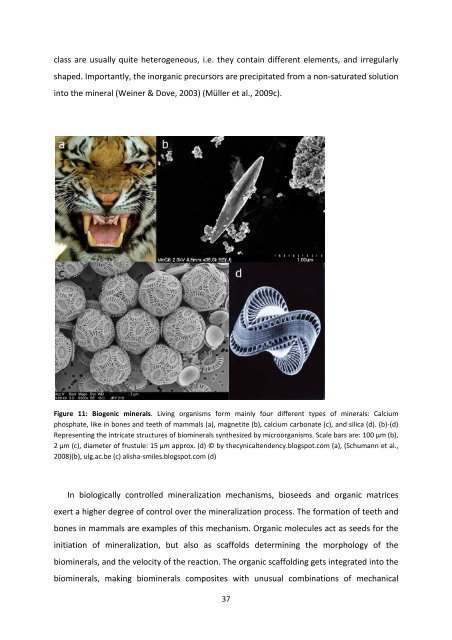MASTER THESIS Biomimetic potential of sponge ... - IAP/TU Wien
MASTER THESIS Biomimetic potential of sponge ... - IAP/TU Wien
MASTER THESIS Biomimetic potential of sponge ... - IAP/TU Wien
You also want an ePaper? Increase the reach of your titles
YUMPU automatically turns print PDFs into web optimized ePapers that Google loves.
class are usually quite heterogeneous, i.e. they contain different elements, and irregularly<br />
shaped. Importantly, the inorganic precursors are precipitated from a non-saturated solution<br />
into the mineral (Weiner & Dove, 2003) (Müller et al., 2009c).<br />
Figure 11: Biogenic minerals. Living organisms form mainly four different types <strong>of</strong> minerals: Calcium<br />
phosphate, like in bones and teeth <strong>of</strong> mammals (a), magnetite (b), calcium carbonate (c), and silica (d). (b)-(d)<br />
Representing the intricate structures <strong>of</strong> biominerals synthesized by microorganisms. Scale bars are: 100 µm (b),<br />
2 µm (c), diameter <strong>of</strong> frustule: 15 µm approx. (d) © by thecynicaltendency.blogspot.com (a), (Schumann et al.,<br />
2008)(b), ulg.ac.be (c) alisha-smiles.blogspot.com (d)<br />
In biologically controlled mineralization mechanisms, bioseeds and organic matrices<br />
exert a higher degree <strong>of</strong> control over the mineralization process. The formation <strong>of</strong> teeth and<br />
bones in mammals are examples <strong>of</strong> this mechanism. Organic molecules act as seeds for the<br />
initiation <strong>of</strong> mineralization, but also as scaffolds determining the morphology <strong>of</strong> the<br />
biominerals, and the velocity <strong>of</strong> the reaction. The organic scaffolding gets integrated into the<br />
biominerals, making biominerals composites with unusual combinations <strong>of</strong> mechanical<br />
37

















